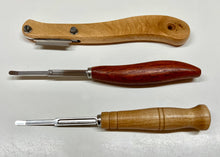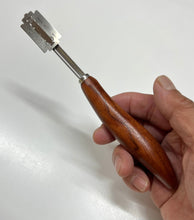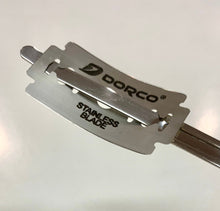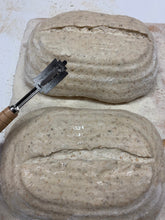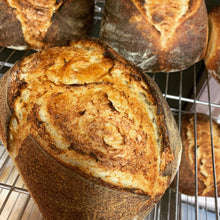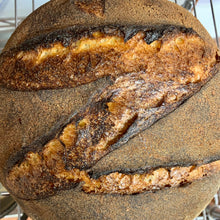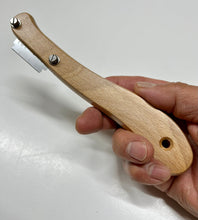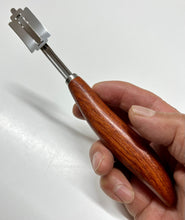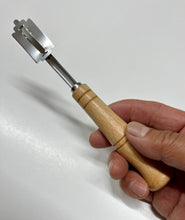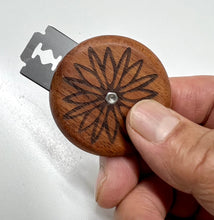Bread Lame Knife - For scoring loaves of bread
Regular price
$22.95
Sale
Bread Lame knives are bread dough cutting knives (which use the double edged thin razor blades) for scoring the proven loaf before it is placed into the oven.
The scores (cuts) you make, beside giving the finished loaf an attractive appearance, controls where the loaf expands when baking. The loaf expands where you score, thus preventing it expanding anywhere else causing the loaf to become mis-shapen and looking amateurish!
You are purchasing ONE Lame knife of your choice which includes a pack of 5 double sided coated stainless steel razor blades. One blade edge will score 50 loaves, so a double edged razor blade will score 100 loaves, and the pack of 5 blades, 500 loaves. You'll be doing well if you use up a pack of blades in a year!
BONUS ... Complimentary sachet (aprox 10g) of organic diastatic malt powder (a natural bread dough enhancing additive for superior crust colour, flavour and nutrition) for you to try in your bread dough. Organic Farm NZ certified #1533.
Choose from any ONE of these 4 Lame types ...
Photo 1 from top:
The Horst Redux - Straight cut. Blade is set flat in handle so will provide a straight incision in the dough loaf. 190mm handle, aprox weight 67g
The Walnut handle shaft - blade is fixed into the stiff shaft and provides a curved angled incision in the dough loaf. Nice weighty handle sits good in the hand and adds weight to the score action. 200mm handle, aprox weight 33g
The Classic handle shaft - blade is fixed into the shaft and provides a curved angled incision in the dough loaf. Lighter handle is nimble and easy to use. Good for smaller size hands. 185mm handle, aprox weight 30g
The Discus (photo 2) - used for more intricate art scoring and acts like a pen on the loaf except it is cutting fine scores into the dough surface. Diameter 49mm, aprox weight 15g
* Please note these are NZ Distributor items (not a Brod & Taylor product) and is for sale in New Zealand only.
Here are the Lame how to use instructions:
BREAD LAME KNIVES
Lames are bread dough cutting knives which use the old fashioned double edged thin razor blades for scoring (cutting) the proven loaf before it is placed into the oven.
Lame is pronounced … LAH MEY
The scores, beside giving the finished loaf an attractive rustic appearance, controls where the loaf expands when baking. The loaf expands where you score, thus preventing it expanding anywhere else causing the loaf to become mis-shapen.
Excellent Youtube scoring video with Cyril Hitz …
http://www.youtube.com/watch?v=rb0lljsKk80
The cutting razor blade is held in place by bending the blade and threading the metal rod through the centre of the blade. When you release the pressure on the blade, its held securely in place by the blade holes and natural blade tension. The blade will be held in a curve position by the metal rod.
Make your scores in the loaf by quickly slashing the dough. Don’t do it slowly as this tends to tear the dough and the blade will bog down. Have in your mind where you are going to score the loaf, then do it with fast action – keeping your other hands fingers well away from the cutting blade please! It is important to have your loaves properly proved at the time you slash and bake. Underproved loaves can burst in funny places when baked. Overproved loaves go flat when baked.
After you have scored the loaf, spray it with cold water then insert quickly into the hot oven. The water mist helps to keep the scores from closing and creates steam in the oven – which is good for the loaves as they spring up for the first few minutes. Handmade artisan lean breads are usually baked at a very high oven temperature of around 240C.
How To Store Flour:
Flour must be kept cool and dry. All flours, even white flour, have a limited shelf life. White stoneground and rollermilled flours have a 12 month shelf life from date of manufacture. The main change that occurs is the oxidation of oils when flour is exposed to air. The result of this is rancid off flavours. During hot weather, store flour in the refrigerator.
Flour should be stored, covered, in a cool and dry area. This prevents the flour from absorbing moisture and odours and from attracting insects and rodents. Freezing flour for 48 hours before it is stored will kill any weevil or insect eggs already in the flour. It is better not to mix new flour with old if you are not using the flour regularly.
Do not store flour near soap powder, onions or other foods and products with strong doors.
If freezer space is available, flour can be repackaged in airtight, moisture-proof containers, labelled and placed in the freezer at 0 degrees F. If flour is stored like this, it will keep well for several years.
Keep whole wheat flour in the refrigerator the year around. Natural oils cause this flour to turn rancid quickly at room temperature. Throw away flour if it smells bad, changes colour, or is infested with weevils.
Flour is always readily available so it should only be brought in quantities that will last a maximum of two to three months.
Put a bay leaf in the flour canister to help protect against insect infections. Bay leaves are natural insect repellents.













